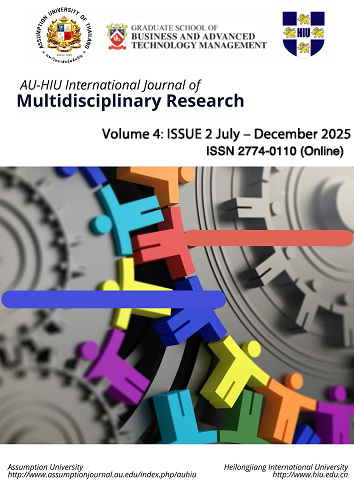The concept of gender equality and family relationship: perspectives from selected neo-urban indian couples in bhopal, india
Keywords:
Gender roles, Family decision-making, Neo-urban couples, Indian marriage, Qualitative researchAbstract
This study explores how gender equality and family relationships are experienced and understood by selected neo-urban Indian couples residing in Bhopal, Madhya Pradesh. Bhopal, a Tier 2 city, reflects a transitional social structure where traditional male-dominated norms coexist with emerging ideas of equality (Desai & Andrist, 2010; NFHS-5, 2021). The purpose of the research is to understand how couples manage their expectations, household responsibilities, and decision-making roles in a society where cultural and gender biases persist (Kabeer, 1999; Rajadhyaksha & Smita, 2004). The study adopts a qualitative approach, gathering data through in-depth interviews of fifteen married couples. Thematic analysis is used to extract key patterns and concerns from their narratives. Word cloud visualization is applied to highlight frequent terms used in the interviews, while sentiment analysis is conducted to detect emotional tones embedded in participants’ responses.
Findings suggest that while most women are financially independent, they continue to bear the majority of domestic work and emotional labor (Hochschild, 1989; Rani & Unni, 2004). Many husbands recognize the value of equal partnerships but still retain control over final decisions, especially related to finances, parenting, and external social interactions (Dyson & Moore, 1983; Rajadhyaksha & Smita, 2004). The study identifies recurring themes such as unequal freedom, cultural conformity, silent compromise, and limited shared decision-making (Sriram & Sandhu, 2013; Basu, 2008). Word frequency analysis supports these findings, revealing dominant terms such as "adjust," "manage," "respect," and "freedom." Sentiment analysis shows a higher proportion of negative or neutral emotional tone in female responses compared to males, who often express contentment or control.
This research offers practical implications for educators, policymakers, and family counselors working in semi-urban Indian settings. It presents a grounded understanding of lived experiences and the gaps between legal gender equality and practical realities. The originality of the study lies in its exclusive focus on neo-urban couples from Bhopal, representing an under-researched demographic, and in combining thematic, visual, and emotional analytics to study evolving family dynamics.
References
Bandura, A. (1977). Social learning theory. Prentice-Hall.
Basu, A. (2008). Violence against women and family relationships: A study in an Indian village. Women’s Studies International Forum, 31(3), 253–263.
Bittman, M., & Wajcman, J. (2000). The rush hour: The character of leisure time and gender equity. Social Forces, 79(1), 165–189. https://doi.org/10.1093/sf/79.1.165
Braun, V., & Clarke, V. (2006). Using thematic analysis in psychology. Qualitative Research in Psychology, 3(2), 77–101. https://doi.org/10.1191/1478088706qp063oa
Creswell, J. W., & Poth, C. N. (2017). Qualitative inquiry and research design: Choosing among five approaches (4th ed.). SAGE Publications.
Daminger, A. (2019). The cognitive dimension of household labor. American Sociological Review, 84(4), 609–633. https://doi.org/10.1177/0003122419859007
Desai, S., & Andrist, L. (2010). Gender scripts and age at marriage in India. Demography, 47(3), 667–687. https://doi.org/10.1353/dem.0.0118
Dyson, T., & Moore, M. (1983). On kinship structure, female autonomy, and demographic behavior in India. Population and Development Review, 9(1), 35–60. https://doi.org/10.2307/1972894
Hochschild, A. R. (1989). The second shift: Working parents and the revolution at home. Viking Penguin.
Israel, M., & Hay, I. (2006). Research ethics for social scientists. Sage. https://doi.org/10.4135/9781849209779
Jejeebhoy, S. J., & Sathar, Z. A. (2001). Women’s autonomy in India and Pakistan: The influence of religion and region. Population and Development Review, 27(4), 687–712. https://doi.org/10.1111/j.1728-4457.2001.00687.x
Jeffery, P., & Jeffery, R. (1997). Don’t marry me to a plowman!: Women’s everyday lives in rural North India. Westview Press.
Kabeer, N. (1999). Resources, agency, achievements: Reflections on the measurement of women’s empowerment. Development and Change, 30(3), 435–464. https://doi.org/10.1111/1467-7660.00125
Kan, M. Y., Sullivan, O., & Gershuny, J. (2011). Gender convergence in domestic work: Discerning the effects of interactional and institutional barriers from large-scale data. Sociology, 45(2), 234–251. https://doi.org/10.1177/0038038510394014
Mathur, A. (2008). Gender socialization and its impact on women’s status: A case study in India. Indian Journal of Gender Studies, 15(2), 241–254.
National Family Health Survey (NFHS-5). (2021). India fact sheet. Ministry of Health and Family Welfare, Government of India.
Papanek, H. (1973). Women in India: Social and economic change. University of Pittsburgh Press.
Patton, M. Q. (2015). Qualitative research & evaluation methods (4th ed.). Sage.
Phadke, S., Khan, S., & Ranade, S. (2011). Why loiter? Women and risk on Mumbai streets. Penguin India.
Rajadhyaksha, U., & Smita, M. (2004). Tracing a timeline for work and family research in India. Economic and Political Weekly, 39(17), 1674–1680. https://www.jstor.org/stable/4414926
Rani, U., & Unni, J. (2004). Employment status of women and gender wage gap in India. Economic and Political Weekly, 39(9), 933–942.
Satir, V. (1983). Conjoint family therapy (3rd ed.). Science and Behavior Books.
Shelton, B. A., & John, D. (1996). The division of household labor. Annual Review of Sociology, 22, 299–322. https://doi.org/10.1146/annurev.soc.22.1.299
Sriram, S., & Sandhu, D. (2013). Gendered communication in Indian families. Journal of Family Communication, 13(4), 291–310.
Tannen, D. (2001). You just don’t understand: Women and men in conversation. Ballantine Books.
Uberoi, P. (2006). Freedom and destiny: Gender, family, and popular culture in India. Oxford University Press.
Downloads
Published
How to Cite
Issue
Section
License
Copyright (c) 2025 John Murukkananikkal, Victoria Appuan

This work is licensed under a Creative Commons Attribution 4.0 International License.


